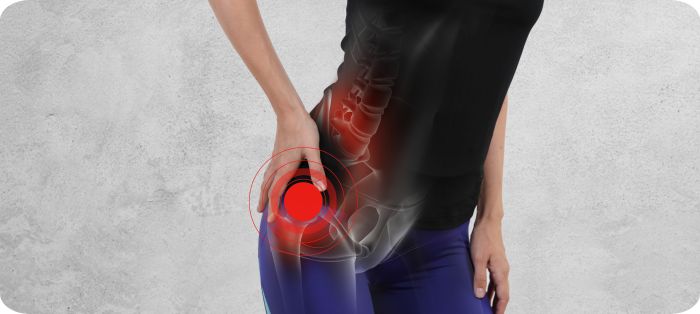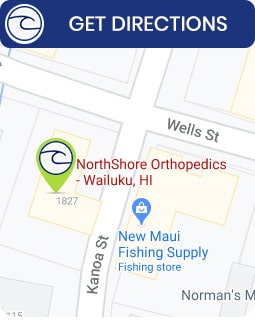Hip Pain Specialist in Maui, Wailuku, HI
At Northshore Orthopedics, Dr. Charles Soma, MD, specializes in providing effective hip pain treatments tailored to your unique needs. Utilizing advanced diagnostic techniques and the latest therapeutic options, Dr. Soma addresses the root causes of hip pain to restore mobility and improve your quality of life. Whether you’re dealing with arthritis, bursitis, or a sports injury, trust Dr. Soma’s expertise to guide you toward a pain-free future. Visit Northshore Orthopedics today and begin your journey to better hip health. For more information, contact us or schedule an appointment online. We are conveniently located at 1827 Wells St # 1, Wailuku, HI 96793.


Table of Contents:
What could be causing my hip pain?
Is surgery necessary for my hip pain?
What are the treatments for hip pain?
Do you offer hip pain treatment in Maui, Wailuku, HI?
Deciphering the Enigma of Hip Pain:
Unraveling the Underlying Causes
Hip pain can be an enigmatic ailment, leaving you wondering why this pivotal joint is causing discomfort. To shed light on the mystery, it’s essential to dissect the potential causes, which can vary widely depending on factors such as age, activity level, and medical history. Understanding these causes is the first step towards finding effective relief for your aching hip.
Unveiling the Musculoskeletal Suspects
Musculoskeletal issues are often the masterminds behind hip pain. Let’s unveil the common culprits:
• Arthritis’s Joint Assault: Osteoarthritis and rheumatoid arthritis, both infamous for causing inflammation and pain, can cripple the hip joint, especially in seasoned adults.
• Bursitis’s Sac Irritability: The bursa, a protective fluid-filled sac, can become inflamed, leading to painful friction. This often occurs due to repetitive hip movements.
• Tendonitis’s Tendon Tension: Overuse or injuries can inflame the tendons surrounding the hip, causing agony.
• Muscle Strains’ Overexertion: Overworking or injuring hip muscles can result in pain and limited mobility.
• Labral Tears’ Cartilage Compromise: The labrum, a cartilage cushion, can tear when subjected to trauma, leading to instability and discomfort.
Nerve-Related Rogues
Nerves can also play a mischievous role in hip pain:
• Sciatica’s Nerve Compression: When the sciatic nerve is squeezed, pain shoots down the hip, leg, and foot.
• Femoral Neuropathy’s Nerve Damage: Damage to the femoral nerve in the thigh can manifest as hip pain.
Vascular and Structural Villains
Structural and vascular conditions can also disrupt hip harmony:
• Hip Impingement’s Bone Conflict: Abnormal bone growth in the hip can cause friction and pain during movement.
• Snapping Hip Syndrome’s Audible Discomfort: A snapping sensation, sometimes accompanied by pain, can indicate this condition.
• Hip Fractures’ Traumatic Impact: These breaks, common in older individuals with weak bones, cause severe pain and demand immediate medical attention.
Infectious Invaders
Infections can wreak havoc on the hip:
• Infectious Assassins: Septic arthritis and osteomyelitis, sneaky invaders, can infect the joint or bone, causing intense pain and requiring prompt treatment.
Other Potential Perpetrators
Other factors can contribute to hip pain:
• Avascular Necrosis’s Bone Malnutrition: Bone tissue dies due to insufficient blood supply, leading to pain.
• Legg-Calvé-Perthes’ Childhood Woes: A rare childhood condition affects the hip joint.
• Slipped Capital Femoral Epiphysis’s Bone Slippage: The upper thigh bone slips out of place.
• Pregnancy’s Hormonal Shifts: Physiological changes during pregnancy can sometimes trigger hip pain.
Contextual Clues: Unraveling the Mystery
Understanding the context of your hip pain can aid in diagnosis:
• Age’s Aging Effects: Osteoarthritis and hip fractures are more prevalent in older individuals.
• Activity’s Impact: High-impact sports or prolonged sitting can overwork the hip joint.
• Weight’s Burden: Excess weight can strain the hip joint.
• Medical History’s Clues: Diabetes and rheumatoid arthritis can increase the risk of hip pain.
Consulting a healthcare professional is essential for an accurate diagnosis and personalized treatment plan. They will employ imaging studies, physical exams, and diagnostic tests to unravel the enigma of your hip pain and guide you towards effective relief.
Navigating the Need for Hip Pain Surgery: A Journey of Diligence and Informed Decision-Making
Determining the necessity of surgery for persistent hip pain is a multifaceted process that demands a thorough investigation and a customized approach. Here’s a comprehensive guide to help you navigate this decision with confidence:
1. Unraveling the Pain’s Cause:
Pinpointing the underlying source of your hip pain is paramount. Common culprits include arthritis, bursitis, torn cartilage (labrum), fractures, muscle strains, hip malformations (dysplasia), excessive bone growth (femoroacetabular impingement), and blood flow impairment (avascular necrosis). Diagnostic tools like X-rays, MRI, and CT scans can illuminate the true nature of your condition.
2. Assessing the Impact:
Consider how severely your hip pain disrupts your daily life. Severe pain that significantly impairs mobility, sleep, and daily activities may warrant surgical intervention.
3. Exploring Non-Surgical Options:
Before contemplating surgery, explore non-invasive treatments to address your pain:
• Physical Therapy: Enhance hip flexibility, stability, and movement.
• Medications: Anti-inflammatories and pain relievers can alleviate discomfort.
• Injections: Steroids can reduce inflammation and ease pain temporarily.
• Lifestyle Adjustments: Weight management, activity modifications, and assistive devices can minimize pain.
4. Duration and Resistance to Treatment:
Persistent pain that defies non-surgical interventions may necessitate surgical evaluation.
5. Identifying the Right Surgery:
If surgery is deemed necessary, the specific procedure will depend on the diagnosis:
• Arthroscopy: Minimally invasive for cartilage tears or bone growth issues.
• Hip Resurfacing: Preserves more bone than traditional hip replacement.
• Total Hip Replacement: For severe joint damage or advanced arthritis.
• Osteotomy: Aligns the hip bones to reduce pain and improve function.
6. Balancing Risks and Benefits:
Carefully weigh the potential benefits of surgery against the risks. Discuss the expected outcomes, recovery time, and possible complications with your surgeon.
7. Considering a Second Opinion:
Seeking a second opinion from an additional specialist can provide an alternative perspective and reinforce your decision-making.
8. Intertwining Individual Factors:
Consider your age, lifestyle, and response to non-surgical treatments when evaluating the need for surgery:
• Age: Younger individuals may be better suited for surgery due to higher activity levels.
• Lifestyle: Physically demanding lifestyles or high mobility expectations can benefit from surgical intervention.
• Failure of Conservative Measures: If non-surgical options haven’t provided adequate pain relief, surgery may be the next step.
Remember, the decision to undergo hip surgery is a collaborative one between you and your healthcare provider. Engage in open and informed discussions to determine the best course of action for your unique situation.
Unlocking Innovative Solutions for Hip Pain Management.
Hip pain, a prevalent ailment, requires multifaceted strategies to alleviate discomfort and restore mobility. This comprehensive guide delves into both conventional and cutting-edge approaches, empowering individuals to navigate this condition effectively.
Non-Invasive Interventions
1. Personalized Rest and Activity Calibration
• Optimized Rest: Identifying and minimizing pain-provoking activities for targeted relief.
• Activity Refinement: Transitioning to low-impact exercises like swimming or cycling to maintain fitness while protecting the hip.
2. Pharmacological Intervention
• Over-the-Counter Choices: Acetaminophen, ibuprofen, or naproxen for mild to moderate discomfort.
• Prescription Medications: Stronger analgesics or anti-inflammatory drugs for severe pain.
• Targeted Drug Therapy: NSAIDs for inflammation reduction, opioids for short-term intense pain management.
3. Physiotherapy-Based Rehabilitation
• Customized Strengthening Exercises: Strengthening hip musculature for improved support and stability.
• Stretching Protocols: Enhancing flexibility and range of motion to optimize hip function.
• Manual Therapy Techniques: Hands-on interventions to facilitate joint mobility and pain reduction.
4. Occupational Therapy Interventions
• Functional Activity Training: Guidance on performing daily activities to minimize hip strain.
5. Lifestyle Modifications
• Weight Optimization: Managing weight to reduce joint stress.
• Ergonomic Adaptations: Designing workspaces and living environments to prevent strain.
• Supportive Footwear: Selecting shoes with adequate arch support to alleviate hip pain.
• Comprehensive Lifestyle Changes: Avoiding pain-inducing activities and adopting proper body mechanics.
6. Adaptive Assistive Devices
• Mobility Assistance: Canes or walkers to ease movement and reduce hip load.
Orthotic Devices: Inserts for enhanced alignment and support.
7. Injectable Therapies
• Corticosteroid Injections: Targeting inflammation and pain reduction.
• Hyaluronic Acid Injections: Lubricating joints and alleviating osteoarthritis symptoms.
8. Complementary and Integrative Approaches
• Thermal Therapy: Applying heat or cold to relax muscles and reduce inflammation.
• Massage Therapy: Relieving tension and enhancing circulation.
• Acupuncture and Chiropractic Care: Alternative therapies with potential benefits for certain individuals.
• Regenerative Therapies: Stem cell and PRP therapies aim to promote tissue repair and healing.
Surgical Interventions
1. Hip Arthroscopy
• A minimally invasive procedure to repair or remove damaged tissue.
2. Hip Resurfacing
A partial hip replacement for younger, more active individuals with localized damage.
3. Total Hip Replacement
A surgical option for severe cases, replacing the entire hip joint with artificial components.
Diagnostic Assessment
Accurate diagnosis is crucial for effective treatment. Diagnostic methods include:
• Comprehensive Examination: Assessing range of motion, pain location, and gait.
• Advanced Imaging: X-rays, MRI, or CT scans to reveal structural abnormalities.
• Laboratory Tests: Evaluating blood samples to exclude infections or inflammation.
Seeking Medical Intervention
Promptly consult a healthcare professional if:
• Pain persists or intensifies.
• Swelling, redness, or warmth accompanies hip pain.
• Sudden, sharp pain occurs.
• Limited mobility or inability to bear weight on the affected leg.
Remember, seeking professional medical advice is essential to receive a tailored treatment plan that addresses your specific hip pain condition and enables you to reclaim mobility and well-being.
Embark on a Journey to Relieve Hip Pain in Maui.
If persistent hip pain casts a shadow over your daily routine, look no further. Our team of expert healthcare professionals is here to guide you towards a pain-free future in the heart of Maui, Wailuku, HI.
Our comprehensive approach encompasses:
• Personalized Consultations: We delve into your unique needs and medical history to tailor a treatment plan that aligns with your lifestyle and goals.
• Non-Surgical Solutions: We explore conservative options first, including physical therapy, targeted injections, and lifestyle modifications to reduce inflammation and enhance mobility.
• Surgical Excellence: When non-surgical measures prove insufficient, our skilled surgeons perform cutting-edge procedures such as hip arthroscopy and total hip replacement, restoring your pain-free movement.
Our compassionate team is devoted to empowering you with knowledge and support every step of the way. Together, we embark on a journey to alleviate your hip pain and reclaim your active and fulfilling life.
Don’t hesitate to contact us today to schedule a consultation and unlock the path to a pain-free future. Visit us online for directions to our leading clinic today! We serve patients from Wailuku HI, Lahaina HI, Kahului HI, Kihei HI, Wailuku HI, Kula HI, Makawao HI, Paia HI, Wailea HI, Haiku HI, Waihee-Waiehu HI, and the surrounding areas.

Additional Services You May Like
▸Fractures & Sprains
▸Knee & Shoulder Injury
▸Platelet Rich Plasma PRP
▸Hand Injury and Surgery
▸Sports Medicine
▸Arthritis Treatment
▸Athletic Injury Recovery
▸Direct Orthopedic Care for Fractures
▸Male Hormonal Evaluations
▸Strains and Sprains
▸Urgent Care
▸X-Ray
▸Worker Comp
▸Back and Neck Pain
▸Wound Management
▸Semaglutide
▸Regenerative Cell Therapy
▸Microneedling With Prp
▸Stem Cell Therapy
▸Knee Surgeon
▸Shoulder Orthopedic Surgeon

Additional Services You May Like
▸Fractures & Sprains
▸Knee & Shoulder Injury
▸Platelet Rich Plasma PRP
▸Hand Injury and Surgery
▸Sports Medicine
▸Arthritis Treatment
▸Athletic Injury Recovery
▸Direct Orthopedic Care for Fractures
▸Male Hormonal Evaluations
▸Strains and Sprains
▸Urgent Care
▸X-Ray
▸Worker Comp
▸Back and Neck Pain
▸Wound Management
▸Semaglutide
▸Regenerative Cell Therapy
▸Microneedling With Prp
▸Stem Cell Therapy
▸Knee Surgeon
▸Shoulder Orthopedic Surgeon





